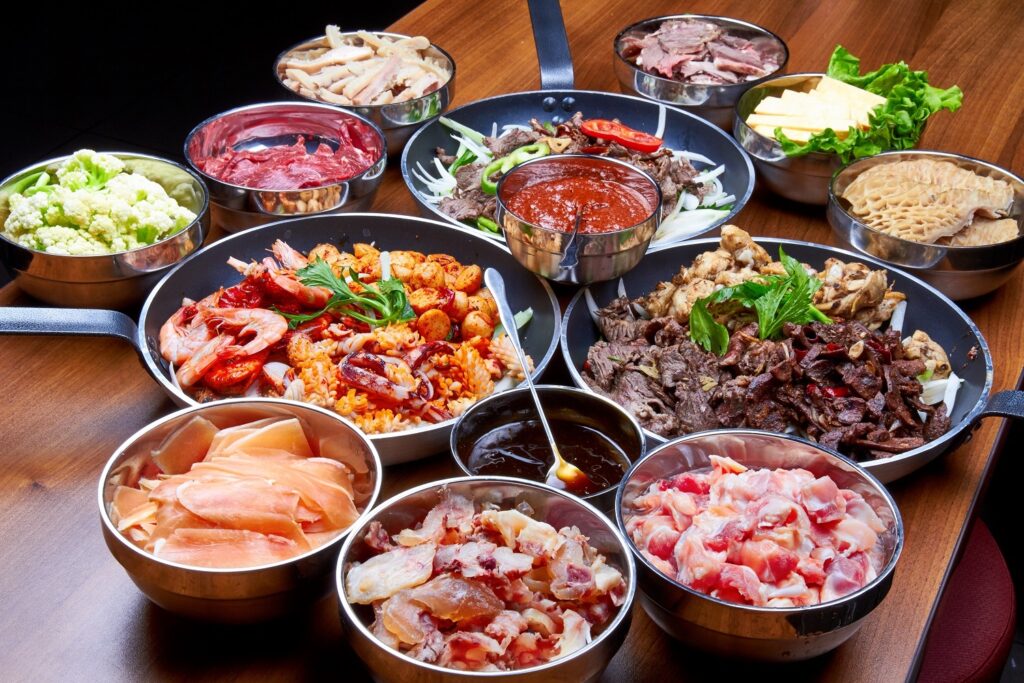
វប្បធម៌អាហារចិន

The culinary culture of China is a profound historical narrative with broad influence, encapsulating various aspects of Chinese history, culture, geography, philosophy, and national character. Let’s delve into this subject from several different perspectives.
From a historical dimension, Chinese culinary culture can be traced back to over ten thousand years ago. From the initial raw food stage to cooked food, natural cooking, and scientific cooking, each phase reflects the environment, technological advancements, and social development. This process has given birth to more than 60,000 traditional dishes and over 20,000 industrial food products, earning China the reputation of being a “Kingdom of Culinary Arts.”
In terms of its connotation, Chinese culinary culture is more than just dishes and cooking skills. It involves the development and utilization of food sources, the application and innovation of tableware, food production and consumption, and the service and hospitality in dining. These elements together constitute a deep and broad cultural system.
From regional and ethnic perspectives, Chinese culinary culture also displays a high degree of diversity. Different regions adapt to local ingredients and dietary habits to create unique dishes and cooking methods. Distinct ethnic groups and religious beliefs also leave unique imprints on the culinary culture.
Regarding its distinctive features, Chinese culinary culture emphasizes the health benefits of food, particularly herbal cuisine and nourishing foods. Dishes are expected to be pleasing to the “eye, nose, and palate,” and must reach the level of a harmonious blend of “five flavors.” Flexibility and innovation are also crucial in cooking to achieve a “transformation between the unconventional and conventional.”
From an international standpoint, the culinary culture of China has had a profound influence on several East Asian countries, and indirectly on Europe, America, and other regions. Many elements, such as vegetarian culture, tea culture, and ceramic tableware, have penetrated deeply into global culture.
In summary, Chinese culinary culture is a multifaceted and multidimensional cultural phenomenon with both depth and breadth. It is not only the product of over 5,000 years of history and life practices of the Chinese people but also a cultural heritage that has a far-reaching impact on human civilization at large.
វប្បធម៌អាហារដ្ឋាននៃចិនជាល្បឿនប្រវត្តិសាស្ត្រដ៏ធំមួយ ដែលមានកម្លាំងប៉ះពាល់ទៅលើចំណុចជឿនលឿននានា៖ ប្រវត្តិសាស្ត្រនៃប្រទេសនេះ វិធីបរិភោគរបស់ប្រទេស ភូមិសាស្ត្រ វប្បធម៌ និងលក្ខណៈរូបភាពរបស់ជនជាតិនេះ។ យើងសាកល្បងស្រាវជ្រាវប៉ុន្មានដល់សំណួរនេះតាមរយៈទិសដៅជាច្រើន។
ពីទិសដៅប្រវត្តិសាស្ត្រ វប្បធម៌អាហារដ្ឋាននៃចិនអាចត្រឡប់ទៅលើជាង១០,០០០ឆ្នាំកន្លងមក។ ជាពីការចាប់ផ្ដើមនឹងសារធាតុសន្សំដល់សារធាតុចាំបាច់ ការចម្អិនច្រើន និងការចម្អិនសាមីភូមិន៍ វិធីនេះបានបង្កើតឡើងជាង៦០,០០០ប្រភេទម្ហូបសរុប និងលើសពី២០,០០០ផលិតផលអាហារដ្ឋានបរិស្ថាន បានជួយឲ្យប្រទេសនេះទទួលបានសមាជិកភាពជា “ព្រះរាជាណាចក្រនៃវប្បធម៌អាហារដ្ឋាន។”
តាមរយៈសំណត់វាយតម្លៃ វប្បធម៌អាហារដ្ឋាននៃចិនគឺលើសពីគ្រាប់គ្រងអាហារនិងការចម្អិនប៉ុណ្ណោះ។ វារួមបញ្ចូលការអភិវឌ្ឍន៍និងការប្រើប្រាស់ប្រភពអាហារ ការអនុវត្តន៍និងការចំណាយបរិភោគ និងសេវាកម្មនិងសន្និសីទក្នុងការបរិភោគ។ ធាតុទាំងនេះបង្កើតឡើងនូវប្រព័ន្ធវប្បធម៌ដ៏អស្ចារ្យនិងធំ។
ពីទិសដៅតំបន់និងជនជាតិ វប្បធម៌អាហារដ្ឋាននៃចិនក៏បង្ហាញឡើងជាកម្លាំងជាច្រើនលំដាប់។ តំបន់ផ្សេងៗបានកែប្រែទៅតាមសារធាតុដែលអាចស្រោបស្រាយនៅក្នុងតំបន់នោះ បង្កើតឡើងនូវម្ហូបនិងវិធីចម្អិនដែលមានភាពចំណាស់សំណាល់។
ពីលក្ខណៈពិសេស វប្បធម៌អាហារដ្ឋាននៃចិនផ្តល់នូវការយល់ដឹងពីប្រយោជន៍សុខភាពនៃអាហារ ជាពិសេសនៅក្នុងម្ហូបដែលមានជំនឿជាប់និងអាហារដែលមានប្រយោជន៍សុខភាព។
ពីទិសដៅអន្តរជាតិ វប្បធម៌អាហារដ្ឋាននៃចិនមានកម្លាំងប៉ះពាល់ដ៏ធំលើសប្រទេសនៃអាស៊ីខាងកើត និងបន្ទាប់មកលើអឺរ៉ុប អាមេរិក និងតំបន់ផ្សេងៗ។
ដូច្នេះ វប្បធម៌អាហារដ្ឋាននៃចិនជាអ phenomena នៃវប្បធម៌ដ៏សំបូរសមភាពនិងមរណមណាៗមួយ ដែលមានកម្រិតកម្រិតនិងប្រវែងប្រយោជន៍។ វាជាផលិតផលនៃប្រវត្តិនិងការអនុវត្តជីវិតលើកម្រិតជាតិនៃប្រជាជនចិនលើកម្រិតជាតិនៃប្រជាជនចិនជាង៥,០០០ឆ្នាំ ហើយក៏ជារង្វាន់វប្បធម៌ដែលមានកម្លាំងប៉ះពាល់ទៅលើសង្គមមនុស្សទូទាំងពិភពលោកផងដែរ។
